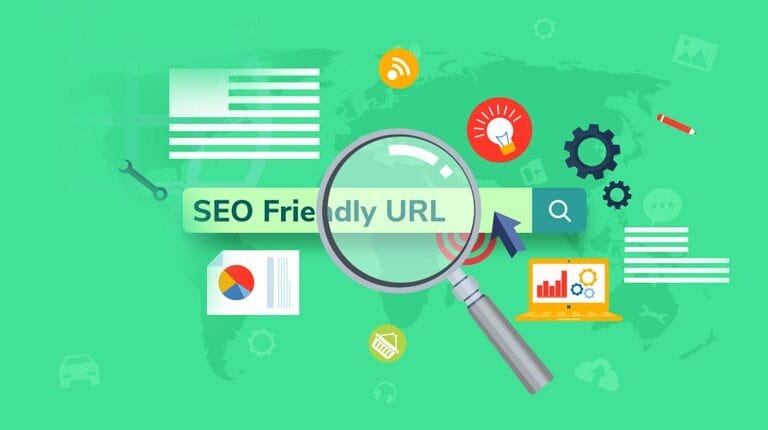How to Write an SEO-Friendly URL Using the Best Keywords
Well-optimized URLs are essential for both SEO and customer experience. Google SEO-friendly URLs are among the many variables that search engines consider when making decisions. URLs, like title tags, help search results and visitors alike describe a web page, so they should be precise, appealing, and properly structured. But how to create SEO friendly URLs?
Table of Contents
What exactly are SEO-friendly URLs?
Search engine-friendly URLs are those that are tailored to the needs of search engines and users. URLs optimized for SEO, in particular, are short and keyword-rich.
What is the significance of SEO-Friendly URLs in SEO?
Google uses your webpage’s URL, together with your title tag, affiliate links, and content, to determine what your content is about.
Here are some best practices for how to create SEO-friendly URLs?
Describe your blog content.
By reading the URL, a viewer should be able to assess the subject matter of a web page. To achieve this, the URL should contain a precise phrase or term related to the content.

Separate words with hyphens.
Spaces are not used to separate words in URLs. Hyphens are used between words in SEO best practices because they tell Google and users where the breaks between words are and are much easier to read than having all the words smashed together. It is critical to use punctuation marks to split words in URL keywords for both user comprehension and engine optimization. Google suggests using hyphens (-) rather than underscores (_) in URLs since hyphens are considered as spaces between two words, whereas underscores link words together.
URL EXAMPLE
Optimized: https://example.com/article/url-website-tips
Not optimized: https://example.com/article/url_website_tips
Use lower case alphabet.
In your URLs, avoid using uppercase letters. Capital and small letters in URLs can be deciphered by search results, resulting in copied URLs and lowered page ranking.
URL EXAMPLE
Optimized: https://example.com/blog/url-website-tips
Not optimized: https://example.com/blog/URL-Website-Tips
Keep SEO friendly URLs brief.
A web page’s URL must be as explanatory and concise as possible. Short URLs are easier to type and interpret. Furthermore, the fewer words there are, the more worth each word gets from a search engine spider. Too many similar words in a URL may be interpreted as relevant keywords, resulting in a drop in search engine rankings. Do keyword research and use 1-2 important keywords in your URL to tell Google when the page must appear in search engine results. Don’t use more than that in your URL since it might appear spammy. Use a keyword from the webpage or post’s title. In addition to the URL, you should include these keywords in your page’s meta tags since Google highlights these words in search engine results, making your website stand out even more.
Make use of Static URLs.
It is preferable to use static, non-changeable URLs whenever feasible. These are URLs that do not change with every load time. Avoid using unwarranted variables like “&,” “?,” and “=”, which are prevalent in dynamic URLs. Static URLs are simpler to read for both search engines and users. This is not to say that you can’t add additional variables to URLs you’ll be publishing on social media that will help track marketing information, but you should prevent hard-coding dynamic URLs immediately into your site.
Numbers can be perplexing, though not always.
Remain vigilant and buy the spelled-out variant of the web address if your business name and the root domain contain a number. Then point it to your main domain. As a result, if somebody is confused or probably doesn’t even know the spelling, they will almost certainly end up on the website.
Try to avoid using any statistics after the root domain at all costs. Consider how people write. When looking for anything online, 4 can instantly be confused with “for” or 2 with “to,” so it’s wise to avoid confusion. Undoubtedly, if the number is a year or a particular date, use numbers rather than spelling. Numbers should be spelled out (on most times)If it’s a longer number, the more probable it is to get identified as the actual number, such as 47, rather than spelling out forty-seven. You get the idea.
The use of numbers in your URL is dependent on the circumstance. Simply weigh the variables and decide whether it is best to incorporate or spell them out or exclude them.
Be Wary of Subdomains.
It is critical to remember that search engines may address a subdomain as a distinct entity from the main domain. This can have an impact on many factors of SEO, such as inbound marketing and trust value. If you have a valid reason to use a subdomain name, subfolders are preferable.
Example Of Links
Optimized – https://www.sample.com/blog/
Not Optimized – https://blog.sample.com/
Dates should be removed from blog posts.
Removing post dates from blog entry URLs lets content stay relevant to search queries because people get the most up-to-date information. URLs without date and time can enhance search engine click-through rates and help information rank for years.
There is no need to redraft your articles with the date unless the article is about a specific incident or day, but doing so may even result in a lower click-through rate because people are reluctant to read an old post from 2013 than a recent publication.
It also supports evergreen content, allowing you to go back and keep updating high-performing articles with fresh content before republishing the post with a new date without needing to redirect the old URL.
Limit the number of folders in the URL framework.
There should be no unrequired folders in a URL. Simply use the number of directories and characters required for your Website address. The flatter the structure of your site, the better. Using these SEO-friendly URL industry standards should help your website rank higher in the search engines and tempt website users to visit your documents. User experience is an important aspect of URLs and all factors of SEO.
Using these SEO-friendly URL best practices must help your website rank higher in search results and tempt visitors to click on your pages. Usability is an important part of URLs and all factors of SEO. Keep the visitors in mind at all times. Another thing to keep in mind is that Google likes to alter the rules. Keep an eye out for developments in the SEO world.
Using HTTP on your website.
HTTPS is the HTTP protocol’s secure version. A Secure Sockets Layer (SSL) encrypts interactions between your browser and the web server so that hackers cannot read it even if they intercept it.
HTTPS increases the credibility of your website by instilling trust in users—they feel safer buying a product with their credit card details, address, and mobile number. This one appears simple, but only 69% of all websites presently redirect to HTTPS. If your website is only HTTP, you’re losing prospective consumers who are tech-savvy.
Different URL structures are possible.
Not every website employs the same URL configuration. That’s fine. The URL configuration of a website is determined by the website’s specific requirements. A URL for an international site, for example, will most likely be framed for numerous languages or places. A blog website’s URL structure may vary from that of an online store or membership site.
A federal govt website’s URL link building will almost certainly differ from that of a social media network.
The URL structure will vary depending on the objective of the website, but it doesn’t matter what structure is chosen, basic success factors still apply to maintain a good URL structure.
Remove all stop words.
Stop words (and, the or, an, of, to, a, for, and so on) are not required in your URL. To keep your URL smaller and more legible, remove these phrases. I replaced the word “for” from the URL of this post to make it smaller and simpler and collectible.
Redirect outdated URLs.
You will almost certainly make modifications to your website over time, and you may pick a new URL structure only to modify it later to enhance functionality. It is best practice and suggested in this case to include lasting redirects. Redirects make sure that there are no broken links for humans or robots.
When you edit or change a URL, include a 301 redirect so if people click the old URL, they are instantly redirected to a different URL rather than seeing a damaged 404 error page. However, too many redirects can cause your website to slow down. One or two reroutes are acceptable, but it is preferable to make the webpage accessible with no 404 error loops. That’s why it’s critical to choose a good URL framework early on in the life of your website—to avoid redirects!
Why is URL structure important for SEO? And How to Create SEO Friendly URLs?

Google SEO friendly URLs organize the content of your website. They serve as the interface between your subject matter and the user. URL structure is important for two reasons:
The User Experience
When it comes to SEO, the most important factor is a great user experience. Use a rational URL structure with page hierarchical structures to improve your customer experience. Humans will find it easier to explore your website if the content is subjectively arranged. You like to make your site as simple to use as possible so that visitors can navigate it with conviction rather than uncertainty.
Use SEO-friendly URLs in comparison to logically constructing your URLs. SEO-friendly URLs are easy to read and include search terms that describe the material on a web page.
If you’re looking for information about baked foods, for example, a URL like https://en.wikipedia.org/wiki/bakedfoods will help you decide whether or not to click on that link.
A URL like https://www.sample.com/index.php?id wca=470&clcp27sap is not friendly and does not fully define what the target page is about.
Better user experience is provided by simple URLs. Optimize URLs with explanatory keywords that convey a full idea of the page’s information. You should improve your Google SEO friendly URLs as it helps search engine crawlers deliver effective findings to users and lets users understand precisely what they’ll see if they visit the website.
PageRank Increases With SEO Friendly URLs
URL frameworks inform Google about the content of various pages on a website and also how they associate with each other. Inbound marketing (links to web pages within your website) also helps.
This means that optimized URL structures help Google PageRank (PR). PageRank is the method by which Google determines the worth of a new website page and its significance to a user’s query.
When you maximize your URLs for people, you also make it a lot simpler for search engine chatbots to crawl and index your webpage so that searchers can find the relevant content. Google uses URLs as a ranking factor.
Google uses Seo Friendly URLs as a ranking factor
This means that optimized URL structures help Google PageRank (PR). PageRank is the method by which Google determines the worth of a web page and its significance to a search term.
Root domains typically have the most PageRank, and while using keywords in your root pages can help your rankings, you shouldn’t rely solely on URL search terms to rank. Avoid cramming URLs with keywords and include what is relevant. SEO-friendly hyperlinks increase the probability that the link will be clicked, which can increase your PageRank.
After your website goes live, and whenever you make changes to page URLs, (re)submit your sitemap to Google Search Engine.
Conclusion for Creating SEO-friendly URLs
The URL framework of a website can vary based on the requirements of the website. We’ve gone over several methods for creating SEO-friendly URLs. Whether you construct a new webpage or not, a Google SEO-friendly URL is critical to your Seo optimization.
Make your URL as short, precise, and to the point as possible. A URL Shortener can help you improve your URLs and monitor their performance. An SEO-friendly URL improves the customer experience while boosting your chances of ranking high in search results. If all of this seems overwhelming, you can hire an SEO agency to take care of all SEO marketing services and boost your website’s visibility.

Vaibhav Kakkar is the Founder and CEO of Digital Web Solutions, a globally trusted agency with a full suite of digital marketing services and development solutions. Vaibhav believes in building systems over services and has helped scale up agencies from scratch to niche leaders with million-dollar turnovers.










